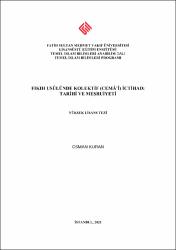| dc.contributor.advisor | Ünalan, Abdülkerim | |
| dc.contributor.author | Kuran, Osman | |
| dc.date.accessioned | 2021-08-19T16:08:11Z | |
| dc.date.available | 2021-08-19T16:08:11Z | |
| dc.date.issued | 2021 | en_US |
| dc.identifier.citation | KURAN, Osman, Fıkıh Usûlünde Kolektif (Cemâ’î) İctihad: Tarihi ve Meşruiyeti, Fatih Sultan Mehmet Vakıf Üniversitesi Lisansüstü Eğitim Enstitüsü Temel İslam Bilimleri Anabilim Dalı Temel İslam Bilimleri Programı, Yayımlanmamış Yüksek Lisans Tezi, İstanbul 2021. | en_US |
| dc.identifier.uri | https://hdl.handle.net/11352/3850 | |
| dc.description.abstract | Bu çalışmada kolektif ictihad teorisi, tarihsel gelişimi ve meşruiyeti bağlamında ele alınmaya çalışılmıştır.
Çalışmanın giriş bölümünde tezin amacı, yöntemi ve kaynakları üzerinden genel bir çerçeve çizilmiştir. Tezin birinci bölümünde konuya girizgâh mahiyetinde ictihad kavramı, tanımı ve fıkıh usûlündeki yeriyle birlikte incelenmiştir. Daha sonra ictihadla ilgili birçok konuyu etkilemesi sebebiyle ictihad eyleminin aşamaları ortaya konulmuştur. İctihad eylemindeki adımları ifade bu aşamalara dair usûl kitaplarında zikredilen ve tartışılan şartlar ve vasıflar incelenmiştir. Bunun akabinde ictihadın müctehidlerin sayısı bakımından türleri ele alınmıştır. Burada bireysel ve kolektif ictihadın tanımlarına yer verilmiştir. Ayrıca kolektif ictihada verilen çeşitli isimler de zikredilmiş, bu isimlendirmelerin sebeplerine değinilmiştir.
İkinci bölümde kolektif ictihad teorisinin tarihî seyri ele alınmaya çalışılmıştır. Bu bağlamda teoriyi ortaya çıkaran oluşum süreci incelenmiş, hangi amillerin bu teorinin oluşumunu tetiklediği ortaya konmaya çalışılmıştır. Teorinin ortaya çıktığı kavramsallaşma süreci, bu teorinin ve fikrin ilk ortaya atıldığı makalenin tarihiyle başlatılmış, kolektif ictihad hedefiyle kurulan ilk müessesenin kuruluş tarihiyle bitirilmiştir. Ardından uygulamaya geçiş dönemi mercek altına alınmıştır. İslâm dünyasındaki kolektif ictihad müesseseleri ortaya konmuştur.
Üçüncü bölümde kolektif ictihad teorisi etrafında sürdürülen meşruiyet tartışmaları ve arayışları incelenmiştir. Bu arayış ve tartışmalar naklî delillere dayanan ve aklî çıkarımlara dayanan istidlaller olmak üzere iki başlık altında ele alınmıştır. Naklî delillerin içerisinde konuyla ilgili âyet-i kerîmeler, Peygamber Efendimiz’den (s.a.v) nakledilen bir takım sözlü ve fiilî sünnetler ve son olarak râşid halifelerin uygulamaları ele alınmaya çalışılmıştır.
Ardından aklî delil ve problemler mercek altına alınmış, toplam sekiz mesele deliller ve problemler olmak üzere iki ana başlık altında incelenmiştir. Deliller başlığı altında delil olarak öne sürülen hususlar, problemler başlığı altında ise eleştiri olarak zikredilen noktalar ele alınmıştır. | en_US |
| dc.description.abstract | In this study, I tried to handle the theory of collective ijtihad in the context of its historical development and legitimacy. In the introduction, a general framework has been drawn over the purpose, method, and sources of the thesis.
In the first part of the thesis, the concept of ijtihad in the form of introduction to the subject is examined with its definition and its place in uṣūl al-fiqh. Then, I classified the stages of the ijtihad activity due to the influence of it on many issues related to ijtihad. The conditions and qualifications which are mentioned and discussed in the uṣūl-books on these stages, are examined. Subsequently, the types of ijtihad in terms of the number of mujtahids were discussed. Here are the definitions of individual and collective ijtihads. In addition, various names given to collective consideration were mentioned and the reasons for these terms were listed.
In the second part, I discussed the historical course of the collective ijtihad theory. In this context, I examined the formation process that gave rise to the theory, and tried to reveal what triggered the formation of this theory. I initiate the conceptual development process in which the theory emerged with an article in which this theory and idea was first published, and end the process with the establishment date of the first institution aiming collective ijtihad. Then, many institutions for collective ijtihad in the Islamic world have been established.
In the third chapter, I examined the discussions on and searches of legitimacy for the theory of collective ijtihad. These searches and discussions were discussed under two headings: evidences based on tradition (naql) and evidences based on the ration (ʿaql). In the traditional/transmitted evidences, it was tried to address the verses, several oral traditions from the Prophet Muhammad and finally the practices of the four caliphs.
Then, I examined the rational evidence and criticisms directed to it, and a total of eight issues were discussed under two main headings as evidence and problems. | en_US |
| dc.language.iso | tur | en_US |
| dc.publisher | Fatih Sultan Mehmet Vakıf Üniversitesi, Lisansüstü Eğitim Enstitüsü | en_US |
| dc.rights | info:eu-repo/semantics/openAccess | en_US |
| dc.subject | İctihad | en_US |
| dc.subject | Kolektif | en_US |
| dc.subject | Bireysel | en_US |
| dc.subject | Cemâʿî | en_US |
| dc.subject | Şurâ | en_US |
| dc.subject | İcmâ | en_US |
| dc.subject | Ijtihād | en_US |
| dc.subject | Collective | en_US |
| dc.subject | Individual | en_US |
| dc.subject | Jamāʿi | en_US |
| dc.subject | Council (Shūrā) | en_US |
| dc.subject | Ijmāʿ | en_US |
| dc.title | Fıkıh Usûlünde Kolektif (Cemâ’î) İctihad: Tarihi ve Meşruiyeti | en_US |
| dc.title.alternative | Collective Ijtihad in Uṣūl Al-Fiqh: History and Legitimacy | en_US |
| dc.type | masterThesis | en_US |
| dc.contributor.department | FSM Vakıf Üniversitesi, Lisansüstü Eğitim Enstitüsü, Temel İslam Bilimleri Ana Bilim Dalı | en_US |
| dc.relation.publicationcategory | Tez | en_US |
| dc.contributor.institutionauthor | Kuran, Osman | |



















